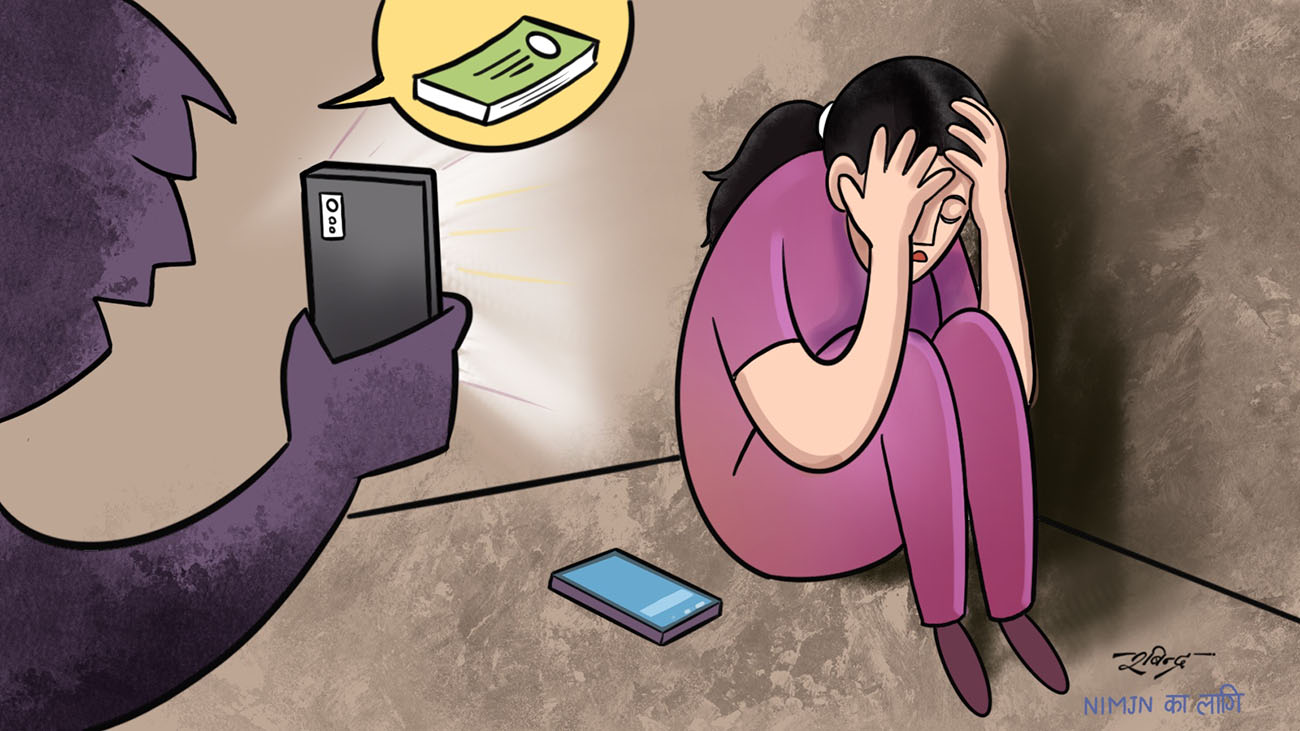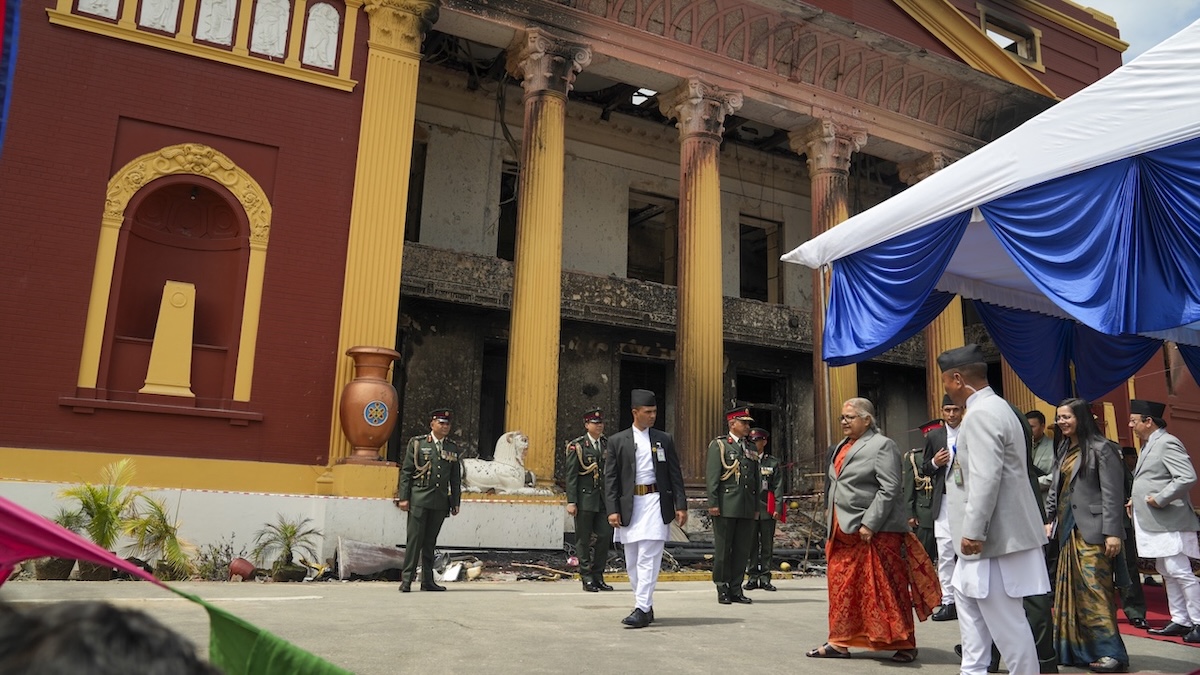Read this story in Nepali: भ्रष्टाचारको भारी मूल्य: ऐतिहासिक धरोहर बन्यो खरानी
In the demonstration organized by Gen Z, demanding an end to corruption and good governance, not only were Nepal’s primary administrative hub, Singha Durbar and the Supreme Court, the pillar of justice, set ablaze, but also the buildings of the Federal Parliament and Provincial Assemblies. In this story, however, we have focused on remembering the Parliament building that was burned down in Baneshwor and its history.
--- ---
On September 8, 2025, participants in a demonstration called by Gen Z, demanding an end to corruption and good governance, broke through the police cordon and entered the Parliament building within the prohibited zone in Baneshwor, Kathmandu.
 Following this, security personnel guarding the Parliament building opened indiscriminate fire, resulting in the deaths of 17 people in Baneshwor alone. Even though 17 lives were lost, the Parliament building itself was not saved.
Following this, security personnel guarding the Parliament building opened indiscriminate fire, resulting in the deaths of 17 people in Baneshwor alone. Even though 17 lives were lost, the Parliament building itself was not saved.
The protest held the next day, in opposition to the youth killed by police bullets on September 8, turned violent. According to the latest police data, 75 people have died in this incident so far, including 62 civilians, three police officers, and 10 inmates. The prisoners were shot by security personnel while attempting to break out of jail.
This protest resulted in the burning of buildings, including Nepal’s principal administrative center, Singha Durbar, the Supreme Court (the pillar of justice), and both the Federal and Provincial Parliament buildings. Police data indicates that damage was caused to 452 police offices, 1,254 government offices, 458 private and commercial buildings, and 259 offices of political parties nationwide.
Demonstrators also vandalized and set fire to media house offices, the residences of leaders affiliated with political parties, and international-standard hotels.
In this story, however, we have attempted to recall the history of the Parliament building that was burned in Baneshwor. This is the same building which, after the end of Nepal’s Panchayat System, was one of the grand, artistic, attractive, and well-facilitated structures built. This building stands as a historical witness to Nepal’s democratic system and its law-making process.
It was here that the Comprehensive Peace Accord, which ended the decade-long Maoist armed conflict, was signed. Through this very agreement, the Maoists returned to mainstream politics. Subsequently, the first meeting of the Constituent Assembly was held in this building, and that meeting abolished the monarchy and declared Nepal’s entry into a federal republic. The new constitution was promulgated from this same building in 2015.
However, after the Gen Z movement, which began on the morning of September 8 and ended the following evening, lasting approximately 36 hours, this building has been reduced to ruins. “This building had a unique grandeur,” said Dhurba Nepal, a resident of Baneshwor Shantinagar, pointing to the burning Parliament building. “It feels like all its luster has been lost.”
Demonstrators set the fire on the afternoon of the 9th. On the same day, after the resignation of then-Prime Minister KP Sharma Oli, they held a victory rally right on the Parliament building premises. Some arrived on bikes and others on foot. A few of the enraged protesters went room-to-room inside the Parliament building and set fire. That blaze continued until the evening of the 10th. Others vented their anger by recording videos on their phones right on the Parliament grounds.
All the furniture, fixtures, and internal structures have been reduced to ashes by the fire. Ekram Giri, the spokesperson for the Federal Parliament Secretariat, stated, “Nothing inside is intact; everything has turned to ashes.”
For the security of the Parliament building, a special armed police force provided round-the-clock protection outside. Even in normal circumstances, more than a hundred security personnel would be deployed here, depending on the situation. More security personnel were added on the day of the protest. Nevertheless, the protestors broke through this security arrangement and set the Parliament building on fire.
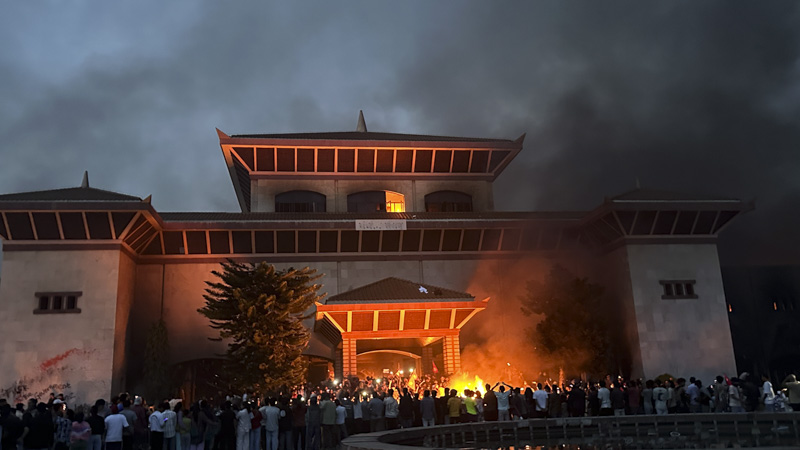
The fire has reduced all physical materials inside the building, from computers, chairs and microphones to everything else, to ashes.
Expensive cameras and electronic equipment, including computers worth millions, which were used to capture and live-stream Parliament sessions, have also been turned to ashes. According to the Parliament Secretariat, the costly furniture in the contact offices of all parliamentary parties, the offices of the Prime Minister, former Prime Ministers, the Speaker, the Chairman of the National Assembly, and the Media Center, has been burned.
According to Spokesperson Ekram, 18 Secretariat vehicles, 36 motorcycles and one ambulance were burned within the building premises. He also mentioned that some security personnel's vehicles were destroyed during the arson.
Even the records of the Parliament's most recent 18th session have been burned. “Records for up to 20 days were brought to Singha Durbar for backup, but 15 to 20 days' worth of records were remaining,” Spokesperson Ekram said. “That record was burned, the device for storing videos was burned, and the Parliament building’s entire server was also burned.”
Designed by Chinese engineers, the building housed seven halls, including one large hall that could accommodate 2,000 people. Alongside the main building was a separate chiller plant that supplied electricity, water and air conditioning to the main structure. The building also featured emergency exit routes to safely evacuate the main building in case of an accident.
The building’s structure featured a pagoda style towards the East-West and North-South directions, an attractive garden with water fountains, and a parking area capable of holding 400 vehicles. This building, which was under the International Convention Centre Development Committee, was leased by the Federal Parliament Secretariat in 2007 to serve as the Parliament House.
After the 2015 earthquake, although there were leaks in some parts of the roof and cracks in the interior walls of the assembly hall, it was repaired by the Development Committee and the Parliament Secretariat and put back into use following a technical inspection. Spokesperson Ekram stated that a technical inspection is still pending to determine whether the building can be used again after the fire.
Within the Parliament building premises, the Investment Board and the Nepal Law Commission were located in the east. To the west were the Rastriya Banijya Bank and a water tank. To the north, the Ministry of Urban Development had been operating a high-standard canteen for three years. These, too, have been reduced to ruins.
Initially, the Development Committee used to charge an annual rent of 70 million rupees but it was currently collecting 160 million rupees annually. The Nepal Law Commission and the Investment Board, being located on the same premises, were also contributing a share of the rent. Spokesperson Ekram stated that the Parliament Secretariat alone was paying about 150 million rupees in annual rent.
What to do with the burned building?
Gen Z refers to the generation born between 1997 and 2012, currently between the ages of 13 and 28. Different groups within this Gen Z generation called for the September 8 protest. Yujan Rajbhandari, a member of one of the groups that called for the demonstration, states that the brutality shown by the government in suppressing the September 8 protest stunned all citizens, which, in turn, led to acts of aggression in some places.
He admits that the role of infiltrators was also evident in the vandalism and arson targeting government property, leaders’ private assets and commercial organizations.
The government has formed a committee to investigate the Gen Z movement. Yujan, who is confident that the truth will be revealed by the committee’s report, says, “As we have repeatedly stated, we cannot just talk about the 9th; we must not forget the truth that unarmed children attending school were killed on the 8th, the day right before.”
Following KP Oli's resignation, an interim cabinet was formed under the leadership of Sushila Karki on September 12 in response to the demands of Gen Z. Stating clearly that this government was established by Gen Z, Yujan says, “Therefore, the responsibility for the reconstruction or preservation of this historic heritage, the Federal Parliament building, in its current state, rests on the shoulders of our government.”
He claimed that the government has already begun the necessary initiatives for the reconstruction of the damages caused during the protest. The government has established a Physical Reconstruction Fund and has appealed to citizens both at home and abroad to provide financial support to the fund.
He is confident that the government will make the necessary decision on whether to reconstruct the Baneshwor Parliament building or preserve it in its current form. He says, “In our understanding, this is not just a structure of bricks and stones, but a symbolic property of the nation; therefore, both its reconstruction and preservation must happen simultaneously.”
Yujan made it clear that they are in favor of re-establishing this building as a symbol of the new generation's democratic journey and accountability.
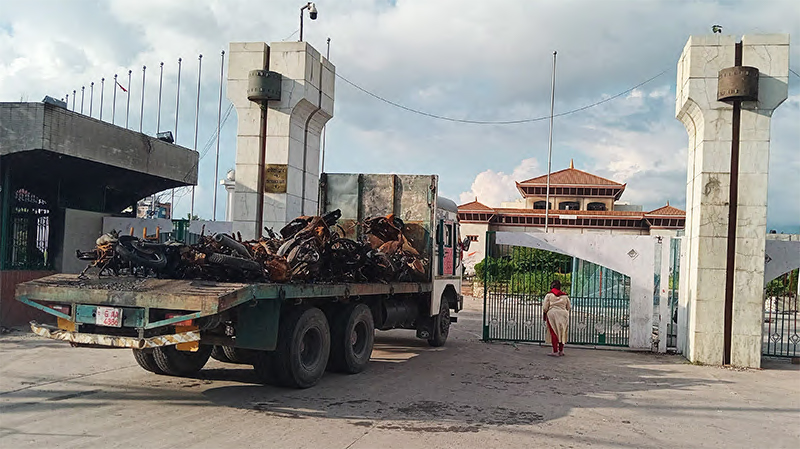
According to the Ministry of Urban Development, no technical assessment has yet been conducted by the Ministry or by engineering organizations to determine whether the building is still usable. “Only the skeleton remains on the outside; the entire inner portion has collapsed and is destroyed. It is not in a usable state,” said Narayan Prasad Mainali, Spokesperson for the Ministry of Urban Development. “It will be difficult to restore it to its previous condition even through reconstruction.”
Ekram Giri, the Spokesperson for the Parliament Secretariat, however, states that the government should work to preserve the building’s historical nature and originality, restoring it to its former state as a heritage site. He added that since the Secretariat was renting the building, it has not formulated any plans for its reconstruction or construction.
“The Parliament that comes next won’t be using this building; we will be using the new building located inside Singha Durbar,” he said. “There is pressure to complete the new building quickly, so Parliament will have the new building by the time the election is completed.” Due to the government’s announcement of the House of Representatives election on March 5, 2026, there is pressure to complete the construction of the Singha Durbar building before that date.
Baneshwor’s identity was transformed
This building was constructed under a financial and technical assistance agreement between Nepal and China in 1987, using a Chinese grant. The foundation stone of the conference center was laid in 1989 by Chinese Premier Li Peng and Nepali Prime Minister Marich Man Singh Shrestha.
The building, which was constructed on the former camp site of the Royal Nepali Army, was inaugurated by the then-King Birendra in November 1993. It was named the Birendra International Convention Center (BICC). It was built three decades ago with a grant of approximately 1 billion rupees and a contribution of 15 million rupees from the Government of Nepal.
After the International Convention Center became the Parliament building, the very identity of Baneshwor was transformed. Even before it housed the Federal Parliament, this building was the venue for national and international programs and conferences.
Radha Bhattarai, a Baneshwor resident, recalled that the atmosphere here used to be captivating, filled with grandeur and fanfare whenever VVIPs visited. Hotels and restaurants also began to pop up around it, making the local market vibrant.
Mohan Shrestha, a permanent resident of Baneshwor and a retired employee of the Ministry of Health, says, “It had developed into a meeting and chatting place where MPs, leaders and high-ranking individuals would gather near the building.” He expressed his sorrow that such a noteworthy national heritage site has been destroyed.
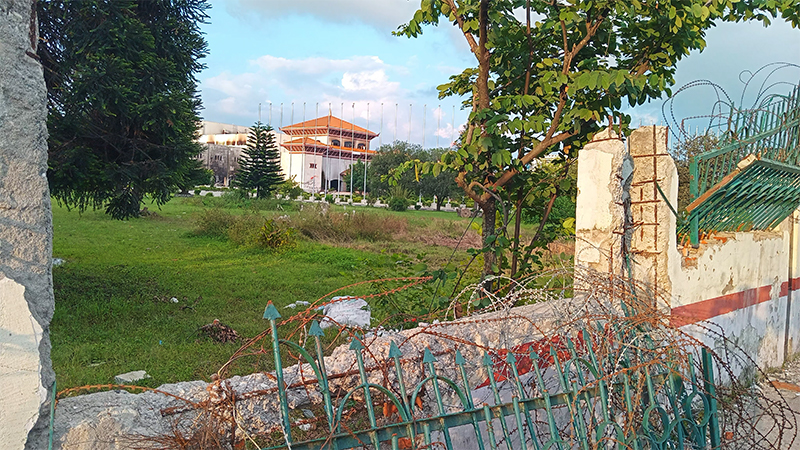
Immediately following the building’s construction in 1993, there was talk of using it to hold Parliament sessions. Surya Kiran Gurung, who was then the Secretary of the House of Representatives, says, “The then-Chinese Ambassador, in the very year construction was completed, suggested that since a new Parliament had been formed, it would be excellent for the Parliament to take this building.”
Surya Kiran informed that he had also consulted with the then-Speaker Daman Nath Dhungana on the matter. Recalling Dhungana's reply, he said, “Daman Nath replied that it would be better if Parliament’s building was constructed with our own resources and means, and that it’s not good to run Parliament from a building made with foreign aid. So, we backed off.”
Following the 2007 election, the Constituent Assembly grew to 601 members. Since there was no other hall in Singha Durbar large enough to hold the Parliament session, the Parliament leased the International Convention Center and made it the Parliament building.
“Even though the Parliament used this building, it could not preserve its parliamentary dignity like a true heritage site. This building became the target of a movement against political anomalies, due process and the system,” said former Parliament Secretary General Manohar Prasad Bhattarai. “Like the proverb, the mouse eats the rice, but the frog gets the injury, this building became the victim.”
The vulgar and indecent insults and protest slogans written by the demonstrators against the outgoing Prime Minister KP Sharma Oli on the building’s walls clearly show the extent of citizen anger against political anomalies.
If you wish to republish this material, please do so according to our republication policy. The republication guidelines are available here.


